The wrens are a family of brown passerines predominately from the New World (the Americas). Most species are inconspicuous and blend with their environments, and have short barred wings. These birds are loud and known for holding their tails in upright positions, especially when foraging. This article uncovers all types of wren birds, including how to identify them and where they live.
House Wren
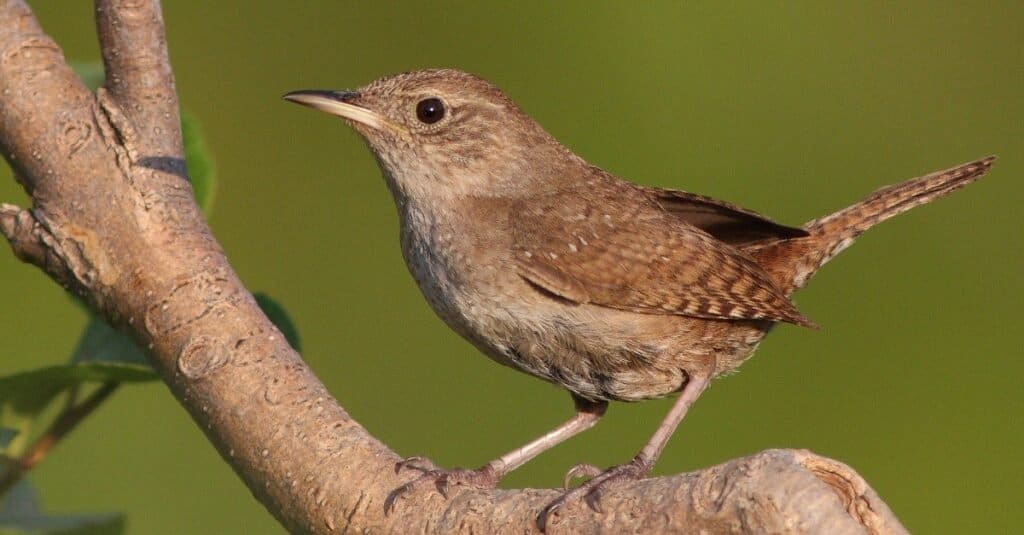
House wrens are native to North and South America.
©iStock.com/mirceax
The house wren is a common sight in backyards. These tiny birds are compact and feature flat heads and curved beaks. They have light to medium brown plumage with dark barring on the wings and pale legs.
This species is native to North and South America, where it is both permanent and migratory in its range. They are permanent in their South and Central American habitats. But they breed in southern Canada and the northern United States, wintering in the southern US and Mexico. They live in many habitats, including forests, swamps, groves, and backyards. You can attract house wrens to your property if you leave out brush piles or make a nesting box.
Calls: Bubbly, excited songs and harsh rattles
Diet: Insects, spiders, snail shells
Fun Fact: They fiercely compete for nesting spots, often dragging eggs and nestlings out of a hole they want.
Cactus Wren
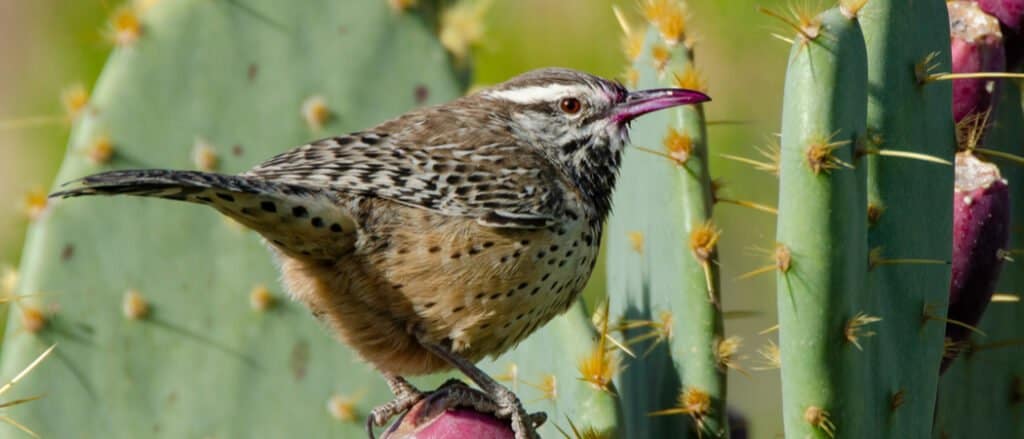
The cactus wren lives year-round in scrubby desert areas.
©Sean R. Stubben/Shutterstock.com
Cactus wrens are noisy desert dwellers endemic to North America. These chunky birds have long bills, rounded tails, and short wings. This species is heavily streaked and speckled with brown, white, black, and tan. Males and females look similar, but juveniles appear paler.
Cactus wrens are nonmigratory, meaning they live year-round in their environments. You can find them in the southwestern United States and Mexico, where they inhabit scrubby desert areas. Look for them perched on cacti mixed with sagebrush and buckwheat. If you live near their habitats, place sunflower seeds and suet in a bird feeder to attract them to your yard.
Calls: Fast, mechanical “chug”
Diet: Insects, cactus fruits, lizards, and seeds
Fun Fact: Parents pluck off grasshopper wings before feeding their young.
Carolina Wren

The Carolina wren eats insects, spiders, and tree frogs.
©Steve Byland/Shutterstock.com
This shy, small bird stays hidden in thickets and swamps, but its loud vocalizations often give them away. Carolina wrens are chunky and feature long, cocked tails and slender, downcurved bills. They are reddish-brown above and buff-orange below, with white faces and white eyebrow stripes. Males and females appear similar. This species is nonmigratory and lives year-round in the eastern half of the United States and Mexico. You can find them in brushy thickets and lowlands swamps most of the time. But they also live in wooded residential areas and farmlands. These birds are common at backyard feeders, especially if you provide nesting boxes and suet.
Calls: Loud “tea-kettle” whistles and rasping calls
Diet: Insects, spiders, tree frogs, small fruits
Fun Fact: They can sing up to 3,000 times in one day!
Marsh Wren
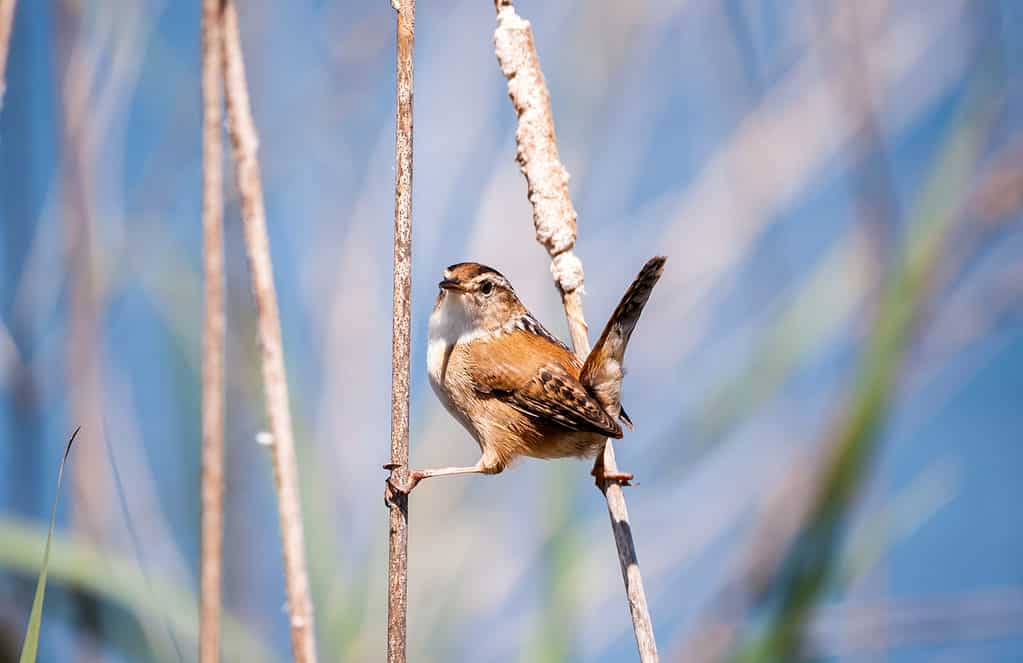
Marsh wrens live in wetlands abundant with cattails.
©iStock.com/maiakphotography
Look for the marsh wren clinging to cattails, looking furtively about its environment. These small birds are plump and feature short tails and thin bills. These birds are chestnut brown with darker plumage on their wings and tails. And their faces are white, featuring thin, white eyebrow stripes. Marsh wrens are partial migrants, with populations occurring year-round in the United States. But some winter further south in Mexico. You can find them in wetlands, especially those with abundant cattails. These birds are not typically backyard visitors.
Calls: Gurgling songs and mechanical chatters
Diet: Aquatic insects, spiders, and snails
Fun Fact: They sing all day, and some even sing throughout the night.
Rock Wren
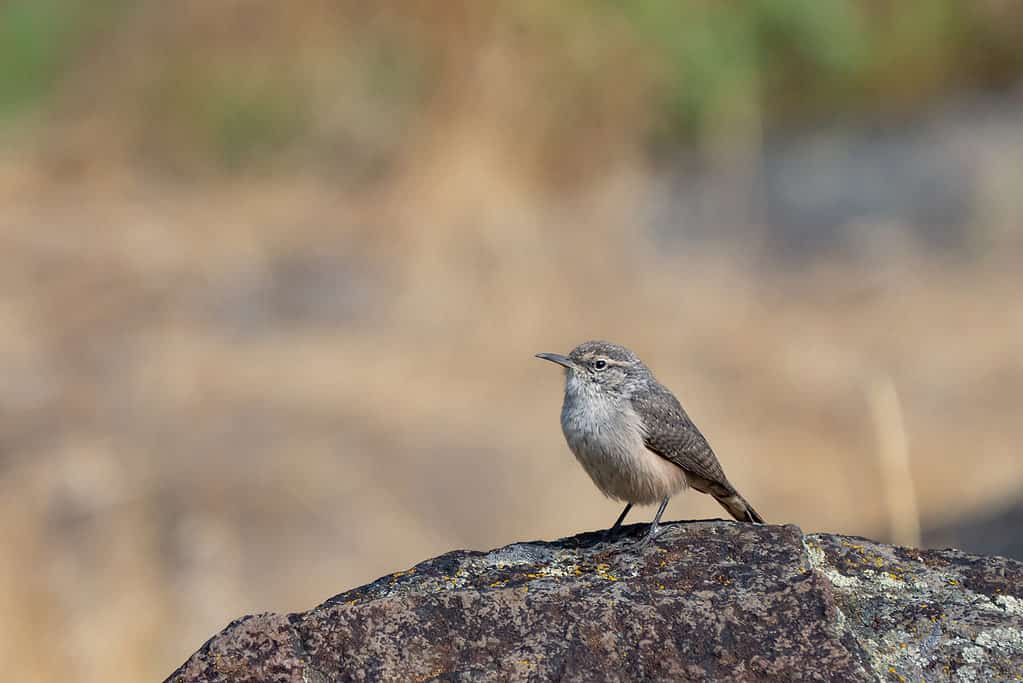
Rock wrens blend with their rocky canyon habitats.
©iStock.com/Jeff Huth
These wrens bounce around dry, rocky canyons and blend with their grayish-brown environments. The rock wren has short wings, long tails, and long, sharp bills. They are pale brown above with gray flecks and whitish below. And their wings and tails have delicate dark brown barring. These birds are short-distance migrants, breeding in the northwestern United States and wintering in the Southwest. You will typically find them in rocky slopes and canyons and do not typically visit backyards.
Calls: Dry trills and rhythmic musical notes
Diet: Insects and spiders
Fun Fact: Males know over 100 songs.
Winter Wren
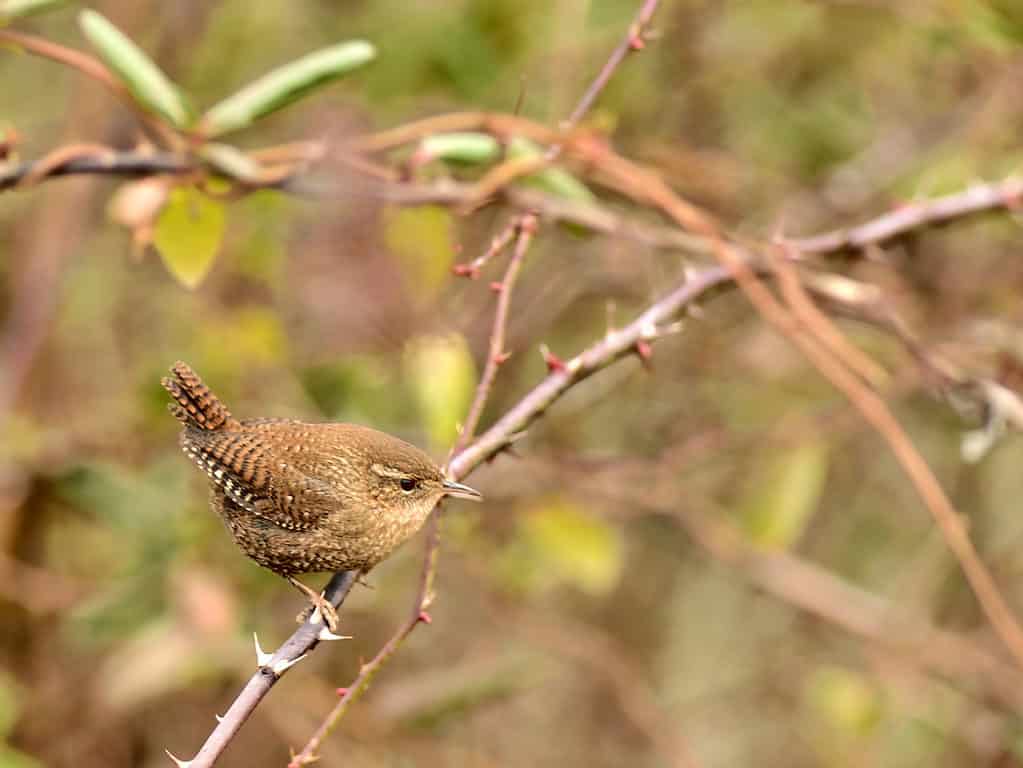
The winter wren lives in evergreen forests in North America.
©iStock.com/Joesboy
The winter wren scampers and creeps around fallen logs, searching for insects and singing its loud, bubbly songs. These birds are plump balls with short, erect tails. Like other wrens, this species is brown overall, with dark brown barring on its wings and tail. They breed in southeastern Canada and the northeastern United States and winter in the southeast. Look for them in evergreen forests, and you can attract them to your property by planting native plants.
Calls: Fast, high-pitched trills and chatters
Diet: Insects, spiders, tiny fish, and berries.
Fun Fact: The males build multiple nests within their territory.
Sedge Wren

Sedge wrens live in sedge meadows and grassy marshes.
©Pablo Rodriguez Merkel/Shutterstock.com
The sedge wren is a well-camouflaged creature that creeps along damp meadows and marshes. It is a tiny wren, smaller than the marsh wren, and features a short, curved bill and short tails. And they feature heavily streaked backs with brown, white, gray, and black, with pale buff undersides. They are short-distance migrants and inhabit the eastern half of the United States and Mexico. You can find them in grassy marshes and sedge meadows, and they do not commonly visit backyards.
Calls: Harsh, simple notes
Diet: Insects and spiders
Fun Fact: The male makes several nest bowls, and the female chooses the one she likes best.
Pacific Wren
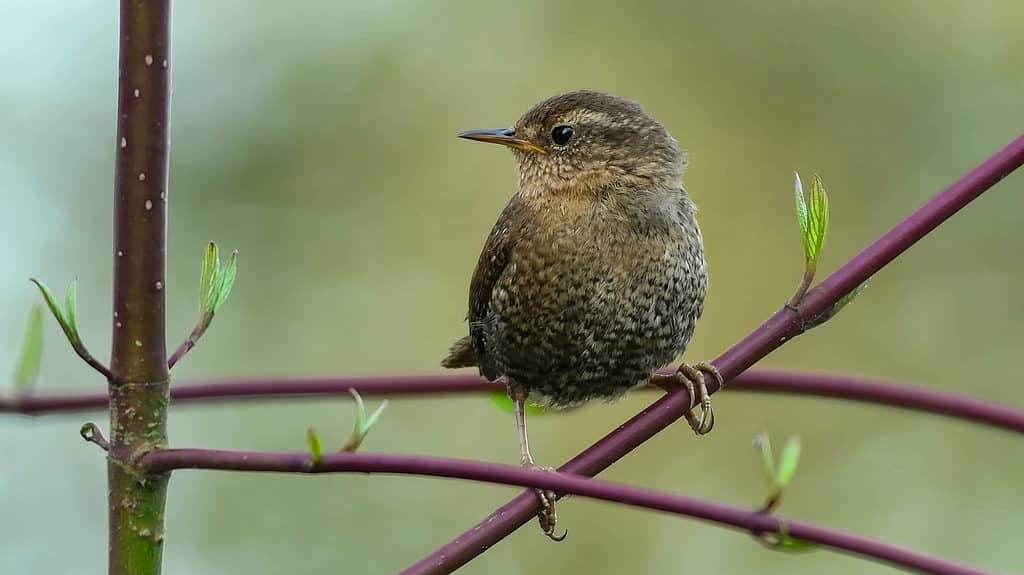
Pacific wrens have long, thin bills and short tails.
©iStock.com/Banu R
These tiny birds are difficult to see as they hop through their dense evergreen forest habitats. Chances are you will hear them before you see them. They are one of the smallest wrens in the United States and feature short wings, short tails, and thin bills. Their plumage is almost indistinguishable from other wrens. They are brown all over with darker barring on the wings and tails. They live along the United State’s west coast, but you can also find them in Canada and Alaska. This bird inhabits forested environments and is most often observed in old-growth evergreens. If you live within their range, you can install a nesting box to attract them.
Calls: Fast, high-pitched trills and chatters
Diet: Insects, spiders, snails, and berries
Fun Fact: Multiple Pacific wrens will pile into one nest box to keep warm.
Bewick’s Wren

The Bewick’s wren lives year-round along the west coast.
©iStock.com/randimal
Bewick’s wrens are common birds of the western United States and a familiar face in open woods. They are larger and more slender than most wren species and feature brown-gray plumage above and gray-white below. Their long tails also have white spots on the edges. They primarily live year-round along the west coast and southwestern United States. You can also find them in Mexico. They prefer to live in brushy areas and thickets in open woodlands. Plant native shrubs in your yard to attract the Bewick’s wren.
Calls: Loud, bubbly warble
Diet: Insects, spiders, berries, and seeds
Fun Fact: Males prevent their partners from mating with another male by foraging together.
Canyon Wren

canyon wrens live on cliffs and canyons.
©iStock.com/graphicphoto
In the west, you can find these birds hopping around canyon walls and rocky cliffs. Their pot-bellied bodies give way to long, slender bills, short wings, and long tails. They feature reddish-brown plumage with white throats and gray heads. Their tails are slightly lighter rusty-brown with black barring. These birds are year-round residents in their environments, where they reside in the western United States and Mexico. They like steep, rocky landscapes, like cliffs, canyons, and rock sides. And their habitat often overlaps with the rock wren. Unless your property backs up to a rocky canyon you won’t find this species in your backyard.
Calls: High, clear descending notes
Diet: Insects and spiders
Fun Fact: They steal insects trapped in spider webs.
Up Next:
The photo featured at the top of this post is © iStock.com/graphicphoto
Sources
- The Wilson Journal of Ornithology, Available here: https://meridian.allenpress.com/wjo/article-abstract/127/3/395/129939/Overlapping-home-ranges-and-microhabitat
- IUCN RedList, Available here: https://www.iucnredlist.org/
- The Cornell Lab of Ornithology, Available here: https://www.birds.cornell.edu/home/
Thank you for reading! Have some feedback for us? Contact the AZ Animals editorial team.






